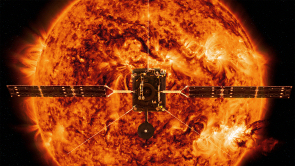Summary
Since the beginning of the 1990s, six unprecedented spacecraft built in Europe for the Ulysses, SOHO and Cluster missions have been investigating the Sun and its impact on our planet. With Solar Orbiter, we will take a close approach to find out ever more about our nearest star.
 |
| Solar Orbiter. Credit: Spacecraft: ESA/ATG medialab; Sun: NASA/SDO/ P. Testa (CfA) |
Solar Orbiter is a mission dedicated to solar and heliospheric physics. It was selected as the first medium-class mission of ESA's Cosmic Vision 2015-2025 Programme. The programme outlines key scientific questions which need to be answered about the development of planets and the emergence of life, how the Solar System works, the origins of the Universe, and the fundamental physics at work in the Universe.
Solar Orbiter will be used to examine how the Sun creates and controls the heliosphere, the vast bubble of charged particles blown by the solar wind into the interstellar medium. The spacecraft will combine in situ and remote sensing observations to gain new information about the solar wind, the heliospheric magnetic field, solar energetic particles, transient interplanetary disturbances and the Sun's magnetic field.
Launched on 10 February 2020, the mission will provide close-up, high-latitude observations of the Sun. Solar Orbiter will have a highly elliptic orbit – between 1.2AU at aphelion and 0.28AU at perihelion. It will reach its operational orbit just under two years after launch by using gravity assist manoeuvres (GAMs) at Earth and Venus. Subsequent GAMs at Venus will increase its inclination to the solar equator over time, reaching up to 24° at the end of the nominal mission (approximately 7 years after launch) and up to 33° in the extended mission phase.
Being close to the Sun allows for observations of solar surface features and their connection to the heliosphere for much longer periods than from near-Earth vantage points. The view of the solar poles will help us to understand how dynamo processes generate the Sun's magnetic field.
The science payload of Solar Orbiter comprises both remote-sensing and in situ instruments. The in situ instruments will operate continuously. During each orbit, the complete instrument suite will be operated around closest approach, and at the minimum and maximum heliographic latitudes – the segments of the orbit where Solar Orbiter will be farthest below and above the solar equator. Since the orbital characteristics will change in the course of the mission, individual orbits will be dedicated to specific science questions.
Solar Orbiter is an ESA-led mission with strong NASA participation. There are ten instruments on board, eight of which have been provided by Principal Investigators through national funding by ESA Member States. A European-led consortium supported by national funding and ESA contributions provided one complete instrument, whilst the remaining instrument and an additional sensor have been provided by NASA. Solar Orbiter was launched from Cape Canaveral aboard an Atlas V 411 rocket provided by NASA.
